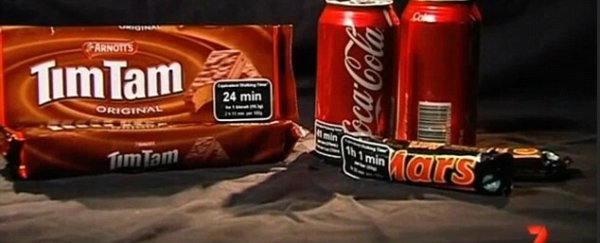In the future, when you pick up a snack at the supermarket, you might be confronted by a packet that tells you how many minutes of exercise it'll take to burn off the contents. At least, that's if a new labelling system proposed by Australian researchers makes it onto shelves.
Trying to find a way to make consumers more aware of the nutritional content of their food (or lack there of) is an ongoing struggle for policy makers. But by simply listing how long you'd have to walk for to burn snack energy off, researchers from Edith Cowan University in Perth have shown how junk food labels could be a lot more effective.
According to their proposal, a packet of Tim Tams would explicitly state that each biscuit takes 24 minutes to burn off, and on a small can of coke it would make it clear that you'd need to walk for at least 41 minutes to use up all the kilojoules inside (ouch). And, unfortunately, a Mars Bar takes just over an hour to walk off.
Currently Australian junk food packets such as chips and chocolate have the 'daily intake guide', or DIG, label on the front. This voluntary label simply explains how much of an average person's daily intake of kilojoules the snack makes up.
But the researchers from Edith Cowan University conducted an independent review into the effectiveness of this system in 2010 and found that there was no scientific evidence to show that the labels actually change "consumer knowledge, awareness, attitudes, purchasing or consumption behaviours".
"For instance, one 500ml energy drink had a single label '16 percent daily intake of energy', which doesn't sound too bad," lead researcher Owen Carter said in a press release. "It's only when you read the little nutrition panel on the back that you learn it also contains 93 per cent of your daily intake of sugar, which is really bad."
Based on this research, Carter's team came up with the 'equivalent walking time' label that could be used on junk food instead. The proposed labels would sit on the front of the packet and simply state the number of minutes of walking the average person would need to do in order to burn off the kilojoules in their snack.
The team has already tested this labelling on 1,000 Australians in an online experiment and have shown that it's far more effective at helping people work out which foods are unhealthy than the DIG label.
"When people were presented with a can of soft drink and told it would take 40 minutes' walking to burn off, all of a sudden a bottle of water with no kilojoules looked much more attractive," said Carter.
The initial results were presented at the 2012 Cancer Council 4th Biennial Research Symposium in Perth, and the researchers have spent the past three years conducting a broader study into the benefits of the labelling system.
Australia's National Health and Medical Research Council has now named the study one of the top 10 best research projects in 2014. However, there's no word as yet on whether the government will be reviewing their food labelling guidelines any time soon.
But with 63 percent of Australian adults and 25 percent of Australian children overweight or obese, it's probably about time we started to look for alternative food labelling solutions. And with the average Australian getting around one-third of their kilojoules through snacks, junk food is a pretty good place to start.
Oh, and in case you were were wondering about how long it takes to burn off more than one Tim Tam, it'll take you 2 hours and 11 minutes to burn off 100 grams, or five and a half biscuits. Because honestly, who stops at one?
